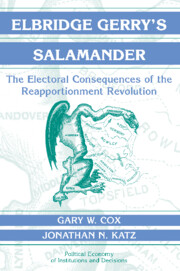Crossref Citations
This Book has been
cited by the following publications. This list is generated based on data provided by Crossref.
Kousser, Thad
2001.
Term Limits and the Dismantling of State Legislative Professionalism.
Carson, Jamie L.
2003.
Strategic Interaction and Candidate Competition in U.S. House Elections: Empirical Applications of Probit and Strategic Probit Models.
Political Analysis,
Vol. 11,
Issue. 4,
p.
368.
Poole, Keith T.
2003.
Changing Minds? Not in Congress.
SSRN Electronic Journal,
Klarner, Carl
2003.
The Measurement of the Partisan Balance of State Government.
State Politics & Policy Quarterly,
Vol. 3,
Issue. 3,
p.
309.
Horiuchi, Yusaku
and
Saito, Jun
2003.
Reapportionment and Redistribution: Consequences of Electoral Reform in Japan.
American Journal of Political Science,
Vol. 47,
Issue. 4,
p.
669.
THOMPSON, DENNIS F.
2004.
Election Time: Normative Implications of Temporal Properties of the Electoral Process in the United States.
American Political Science Review,
Vol. 98,
Issue. 1,
p.
51.
Rallings, Colin
Thrasher, Michael
Johnston, Ron
and
Downe, James
2004.
Redistricting Local Governments in England: Rules, Procedures, and Electoral Outcomes.
State Politics & Policy Quarterly,
Vol. 4,
Issue. 4,
p.
470.
ANSOLABEHERE, STEPHEN
and
SNYDER, JAMES M.
2004.
Using Term Limits to Estimate Incumbency Advantages When Officeholders Retire Strategically.
Legislative Studies Quarterly,
Vol. 29,
Issue. 4,
p.
487.
McDonald, Michael P.
2004.
A Comparative Analysis of Redistricting Institutions in the United States, 2001-02.
State Politics & Policy Quarterly,
Vol. 4,
Issue. 4,
p.
371.
Stone, Walter J.
Maisel, L. Sandy
and
Maestas, Cherie D.
2004.
Quality Counts: Extending the Strategic Politician Model of Incumbent Deterrence.
American Journal of Political Science,
Vol. 48,
Issue. 3,
p.
479.
Schaffner, Brian F.
Wagner, Michael W.
and
Winburn, Jonathan
2004.
Incumbents Out, Party In? Term Limits and Partisan Redistricting in State Legislatures.
State Politics & Policy Quarterly,
Vol. 4,
Issue. 4,
p.
396.
Carson, Jamie L.
and
Crespin, Michael H.
2004.
The Effect of State Redistricting Methods on Electoral Competition in United States House of Representatives Races.
State Politics & Policy Quarterly,
Vol. 4,
Issue. 4,
p.
455.
Engstrom, Erik J.
and
Kernell, Samuel
2005.
Manufactured Responsiveness: The Impact of State Electoral Laws on Unified Party Control of the Presidency and House of Representatives, 1840–1940.
American Journal of Political Science,
Vol. 49,
Issue. 3,
p.
531.
Crespin, Michael H.
2005.
Using Geographic Information Systems to Measure District Change, 2000–2002.
Political Analysis,
Vol. 13,
Issue. 3,
p.
253.
Poole, Keith T.
2005.
Spatial Models of Parliamentary Voting.
McLean, Iain
McMillan, Alistair
and
Leech, Dennis
2005.
Duverger's Law, Penrose's Power Index and the Unity of the UK.
Political Studies,
Vol. 53,
Issue. 3,
p.
457.
Gautier, Pascal
and
Soubeyran, Raphaël
2005.
Political Cycles: The Opposition Advantage.
SSRN Electronic Journal,
Yoshinaka, Antoine
and
Grose, Christian R.
2005.
Partisan Politics and Electoral Design: The Enfranchisement of Felons and Ex-Felons in the United States, 1960–99.
State and Local Government Review,
Vol. 37,
Issue. 1,
p.
49.
Scheiner, Ethan
2005.
Democracy without Competition in Japan.
Johnston, Ron
2005.
Anglo-American Electoral Geography: Same Roots and Same Goals, but Different Means and Ends?*.
The Professional Geographer,
Vol. 57,
Issue. 4,
p.
580.



